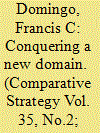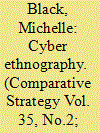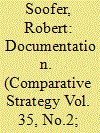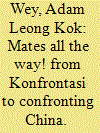| Srl | Item |
| 1 |
ID:
150092


|
|
|
|
|
| Summary/Abstract |
This article investigates the nuclear postures available to Israel in the wake of the Joint Comprehensive Plan of Action (JCPOA) between Iran and the P5 + 1. An “existential bias” pervades much of the literature on nuclear postures. Most scholars assume that once a state acquires the bomb it can deter all forms of aggression. However, recent scholarship has shown this to be untrue given that regional nuclear powers operate under much greater constraints than the U.S. and Russia or the Soviet Union. Israel faces tradeoffs between three postures: a catalytic posture, which would involve greater reliance upon the U.S.; assured retaliation, its current posture; and first use. Should Jerusalem continue to fear the prospect of abandonment by the U.S., it may turn to a first-use posture in order to leverage its conventional and nuclear superiority over its neighbors.
|
|
|
|
|
|
|
|
|
|
|
|
|
|
|
|
| 2 |
ID:
150095


|
|
|
|
|
| Summary/Abstract |
This article explains why powerful states develop capabilities for warfare in cyberspace. It argues that despite the apparent limited strategic utility of cyberspace, powerful states develop cyber capabilities to compete for military dominance in the international system. This argument is best explored using a neorealist framework because it provides the most compelling explanation for the competitive behavior of states in cyberspace. Three key implications can be derived from the study: the proliferation of capabilities for warfare in cyberspace is inevitable; powerful states will still dominate cyberspace; and cyberattacks may escalate to kinetic attacks due to the uncertainties regarding existing cyber capabilities.
|
|
|
|
|
|
|
|
|
|
|
|
|
|
|
|
| 3 |
ID:
150090


|
|
|
|
|
| Summary/Abstract |
There seems to be a current push for intelligence to be more informed through sociocultural analysis. This article argues that a new variation of ethnography, cyber ethnography, is the answer to calls for additional support, and should be incorporated into the Department of Defense (DoD) methodological “tool box.” This article answers: What is cyber ethnography and how could it contribute to United States defense work? What are some of the method's limitations and challenges, especially when performed by DoD personnel? At the same time, what type of community could be studied by the DoD using cyber ethnography? And finally, what are the requirements to perform this method?
|
|
|
|
|
|
|
|
|
|
|
|
|
|
|
|
| 4 |
ID:
150096


|
|
|
| 5 |
ID:
150089


|
|
|
|
|
| Summary/Abstract |
The use of coercive instruments of statecraft and military power to affect changes in strategic behavior is a common feature of international politics. Recently, a variety of state and sub-state actors have attempted to utilize cyber instruments of disruption and intrusion to bring about favorable outcomes. This article notes that digital instruments for coercion offer limited potential for effective compellent effect in world affairs. Nevertheless, as the case of North Korea's 2015 hack and (attempted) manipulation of Sony demonstrates, coercion using cyber weapons of intrusion and disruption is possible under particular conditions. In describing these conditions, I argue that the limits of cyber coercion should be seen more as a function of relevant social and institutional context than of the current state of technological possibilities. Technology certainly determines parameters of coercive interaction between actors, but success—and thus most determinants of strategic decisions surrounding cyber coercion—derives directly from sociopolitical context.
|
|
|
|
|
|
|
|
|
|
|
|
|
|
|
|
| 6 |
ID:
150094


|
|
|
|
|
| Summary/Abstract |
Despite the recent installation of a new, so-called Unity government in Tripoli, unresolved political differences among rival factions and the violence perpetuated by Islamic extremists in Libya suggest any interim stabilization of the country may be short-lived. Declarations that the 2011 intervention in Libya was a success have long been overshadowed by a chorus of critics who argue it created more problems than it solved. Hoping for another casualty-free, short-term intervention is not a realistic option. If the U.S. and regional players wish to right Libya's course, and cement it indefinitely, it will require a major and long-term in-country commitment that few would find politically or fiscally palatable. Diving in deeply or largely staying out appear to be the only real-world choices available.
|
|
|
|
|
|
|
|
|
|
|
|
|
|
|
|
| 7 |
ID:
150093


|
|
|
|
|
| Summary/Abstract |
Australian and Malaysian strategic relations have evolved since the independence of Malaya in 1957 and the formation of Malaysia in 1963. Confronted with an aggressive neighbor, Indonesia set to “crush” Malaysia during its infancy years. The United Kingdom with Australia embarked on a military expedition to aid Malaysia in fighting an “undeclared” war. Australia committed troops in Malaysia and continued to maintain a physical presence in Malaysia after the Konfrontasi ended in 1966, and later under the auspices of the Five Power Defence Arrangements (FPDA). China's recent assertion in the Asian region has precipitated mutual security risks for both Malaysia and Australia, and renewed interests for rigorous strategic cooperation. This article describes the power of geographical space and location, and its influence on the strategic context and logic of Australia-Malaysia strategic relationship.
|
|
|
|
|
|
|
|
|
|
|
|
|
|
|
|
| 8 |
ID:
150091


|
|
|
|
|
| Summary/Abstract |
The political and military dexterity required for nuclear crisis management during the Cold War was sufficiently stressful for policymakers and military advisors. Even more uncertain is the information environment of the twenty-first century and the “second nuclear age” with respect to its implications for the use of nuclear forces in coercive bargaining. Nuclear crisis management requires a degree of transparency about ongoing military operations and political maneuvers and, in addition, a certain amount of mutually shared trust in the negotiating process itself. Cyberwar undertaken by disputants before or during a nuclear crisis could introduce additional uncertainty and doubt into the reciprocal process of bargaining for an agreed settlement short of war.
|
|
|
|
|
|
|
|
|
|
|
|
|
|
|
|